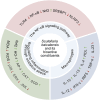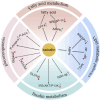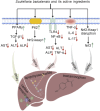Scutellaria baicalensis Georgi in metabolic-associated fatty liver disease treatment: research progress
- PMID: 40538532
- PMCID: PMC12177340
- DOI: 10.3389/fphar.2025.1565461
Scutellaria baicalensis Georgi in metabolic-associated fatty liver disease treatment: research progress
Abstract
Metabolic associated fatty liver disease (MAFLD), previously known as nonalcoholic fatty liver disease (NAFLD), is a common liver condition marked by excessive fat accumulation exceeding 5% in the liver without significant alcohol consumption. It is closely linked to metabolic disorders such as obesity, type 2 diabetes, and dyslipidemia, with a rising global prevalence projected to escalate from 25% to 56% over the next decade. The pathogenesis of MAFLD is multifaceted, involving insulin resistance, inflammation, and oxidative stress, with progressive symptoms that can lead to severe liver conditions including non-alcoholic steatohepatitis (NASH). Current treatment options are limited, as established medications show variable efficacy and safety. Scutellaria baicalensis Georgi (S. baicalensis) a traditional Chinese herb rich in flavonoids, has garnered attention for its potential therapeutic effects on MAFLD. Its pharmacological activities, including anti-inflammatory, antioxidant, and lipid-regulating properties, position S. baicalensis as a promising candidate for MAFLD management. This article reviews the latest research progress of S. baicalensis in the treatment of MAFLD, explores its mechanism of action, pharmacokinetics, and the development of related products, aiming to clarify the pathogenesis of MAFLD and promote the development of new treatment and prevention strategies based on traditional Chinese medicine.
Keywords: Scutellaria baicalensis Georgi; metabolic associated fatty liver disease; pharmacokinetics; pharmacological activities; production development.
Copyright © 2025 Chen, Liu, Zhao, Liu, Dong, Lou, Huang, Li and He.
Conflict of interest statement
The authors declare that the research was conducted in the absence of any commercial or financial relationships that could be construed as a potential conflict of interest.
Figures







Similar articles
-
Pharmacological properties of total flavonoids in Scutellaria baicalensis for the treatment of cardiovascular diseases.Phytomedicine. 2022 Dec;107:154458. doi: 10.1016/j.phymed.2022.154458. Epub 2022 Sep 15. Phytomedicine. 2022. PMID: 36152591
-
Phytotherapy as Multi-Hit Therapy to Confront the Multiple Pathophysiology in Non-Alcoholic Fatty Liver Disease: A Systematic Review of Experimental Interventions.Medicina (Kaunas). 2021 Aug 14;57(8):822. doi: 10.3390/medicina57080822. Medicina (Kaunas). 2021. PMID: 34441028 Free PMC article.
-
Non-invasive screening, staging and management of metabolic dysfunction-associated fatty liver disease (MAFLD) in type 2 diabetes mellitus patients: what do we know so far ?Acta Gastroenterol Belg. 2022 Apr-Jun;85(2):346-357. doi: 10.51821/85.2.9775. Acta Gastroenterol Belg. 2022. PMID: 35709779
-
Circulating chemerin levels in metabolic-associated fatty liver disease: a systematic review and meta-analysis.Lipids Health Dis. 2022 Mar 2;21(1):27. doi: 10.1186/s12944-022-01637-7. Lipids Health Dis. 2022. PMID: 35236351 Free PMC article.
-
The Midlands Liver Research Alliance - A partnership to optimise obesity-related liver disease research: targeting areas of high incidence and underserved communities.NIHR Open Res. 2024 Dec 12;4:75. doi: 10.3310/nihropenres.13784.1. eCollection 2024. NIHR Open Res. 2024. PMID: 40547821 Free PMC article.
References
Publication types
LinkOut - more resources
Full Text Sources

